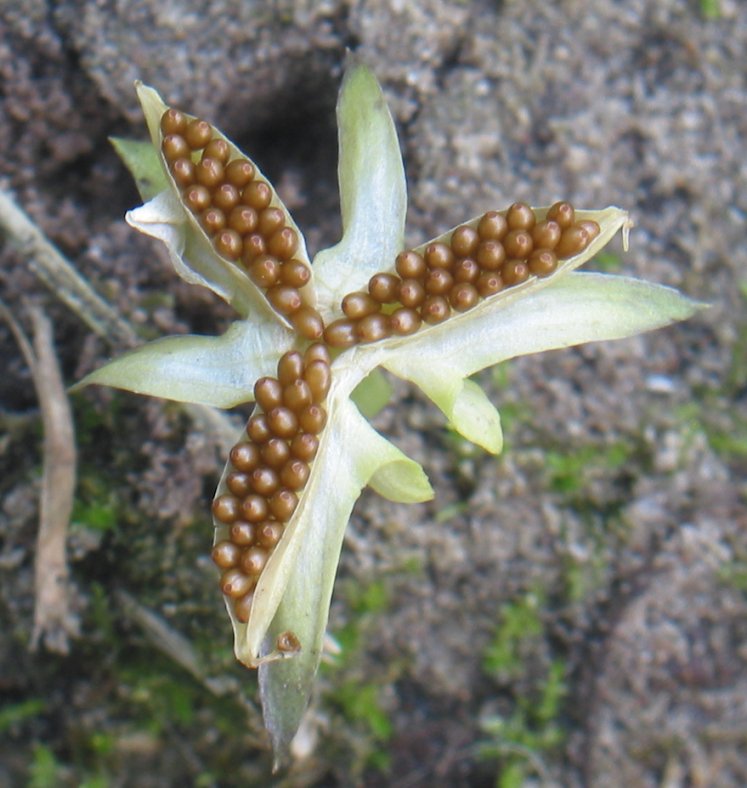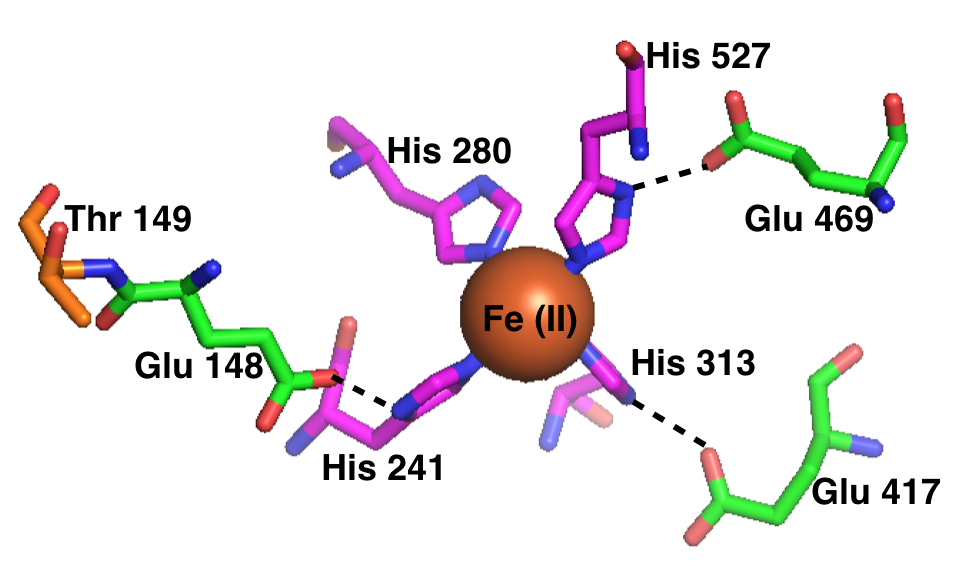|
Ionone
The ionones are a series of closely related chemical substances that are part of a group of compounds known as rose ketones, which also includes damascones and damascenones. Ionones are aroma compounds found in a variety of essential oils, including rose oil. β-Ionone is a significant contributor to the aroma of roses, despite its relatively low concentration, and is an important fragrance chemical used in perfumery. The ionones are derived from the degradation of carotenoids. The combination of α-ionone and β-ionone is characteristic of the scent of violets and used with other components in perfumery and flavouring to recreate their scent. The carotenes α-carotene, β-carotene, γ-carotene, and the xanthophyll β- cryptoxanthin, can all be metabolized to β-ionone, and thus have vitamin A activity because they can be converted by plant-eating animals to retinol and retinal. Carotenoids that do not contain the β-ionone moiety cannot be converted to retinol, and ... [...More Info...] [...Related Items...] OR: [Wikipedia] [Google] [Baidu] |
Vitamin A
Vitamin A is a fat-soluble vitamin and an essential nutrient for humans. It is a group of organic compounds that includes retinol, retinal (also known as retinaldehyde), retinoic acid, and several provitamin A carotenoids (most notably beta-carotene �-carotene. Vitamin A has multiple functions: it is essential for embryo development and growth, for maintenance of the immune system, and for vision, where it combines with the protein opsin to form rhodopsin the light-absorbing molecule necessary for both low-light ( scotopic vision) and color vision. Vitamin A occurs as two principal forms in foods: A) retinol, found in animal-sourced foods, either as retinol or bound to a fatty acid to become a retinyl ester, and B) the carotenoids alpha-carotene, β-carotene, gamma-carotene, and the xanthophyll beta-cryptoxanthin (all of which contain β-ionone rings) that function as provitamin A in herbivore and omnivore animals which possess the enzymes that cleave and con ... [...More Info...] [...Related Items...] OR: [Wikipedia] [Google] [Baidu] |
Carotenoid
Carotenoids (), also called tetraterpenoids, are yellow, orange, and red organic pigments that are produced by plants and algae, as well as several bacteria, and fungi. Carotenoids give the characteristic color to pumpkins, carrots, parsnips, corn, tomatoes, canaries, flamingos, salmon, lobster, shrimp, and daffodils. Carotenoids can be produced from fats and other basic organic metabolic building blocks by all these organisms. It is also produced by endosymbiotic bacteria in whiteflies. Carotenoids from the diet are stored in the fatty tissues of animals, and exclusively carnivorous animals obtain the compounds from animal fat. In the human diet, absorption of carotenoids is improved when consumed with fat in a meal. Cooking carotenoid-containing vegetables in oil and shredding the vegetable both increase carotenoid bioavailability. There are over 1,100 known carotenoids which can be further categorized into two classes, xanthophylls (which contain oxygen) and carotenes (which ... [...More Info...] [...Related Items...] OR: [Wikipedia] [Google] [Baidu] |
Carotene
The term carotene (also carotin, from the Latin ''carota'', "carrot") is used for many related unsaturated hydrocarbon substances having the formula C40Hx, which are synthesized by plants but in general cannot be made by animals (with the exception of some aphids and spider mites which acquired the synthesizing genes from fungi). Carotenes are photosynthetic pigments important for photosynthesis. Carotenes contain no oxygen atoms. They absorb ultraviolet, violet, and blue light and scatter orange or red light, and (in low concentrations) yellow light. Carotenes are responsible for the orange colour of the carrot, after which this class of chemicals is named, and for the colours of many other fruits, vegetables and fungi (for example, sweet potatoes, chanterelle and orange cantaloupe melon). Carotenes are also responsible for the orange (but not all of the yellow) colours in dry foliage. They also (in lower concentrations) impart the yellow coloration to milk-fat and butter. Om ... [...More Info...] [...Related Items...] OR: [Wikipedia] [Google] [Baidu] |
Retinol
Retinol, also called vitamin A1, is a fat-soluble vitamin in the vitamin A family found in food and used as a dietary supplement. As a supplement it is used to treat and prevent vitamin A deficiency, especially that which results in xerophthalmia. In regions where deficiency is common, a single large dose is recommended to those at high risk twice a year. It is also used to reduce the risk of complications in measles patients. It is taken by mouth or by injection into a muscle. Retinol at normal doses is well tolerated. High doses may cause enlargement of the liver, dry skin, and hypervitaminosis A. High doses during pregnancy may harm the fetus. The body converts retinol to retinal and retinoic acid, through which it acts. Dietary sources include fish, dairy products, and meat. Retinol was discovered in 1909, isolated in 1931, and first made in 1947. It is on the World Health Organization's List of Essential Medicines. Retinol is available as a generic medication and ... [...More Info...] [...Related Items...] OR: [Wikipedia] [Google] [Baidu] |
Xanthophyll
Xanthophylls (originally phylloxanthins) are yellow pigments that occur widely in nature and form one of two major divisions of the carotenoid group; the other division is formed by the carotenes. The name is from Greek (, "yellow") and (, "leaf"), due to their formation of the yellow band seen in early chromatography of leaf pigments. Molecular structure As both are carotenoids, xanthophylls and carotenes are similar in structure, but xanthophylls contain oxygen atoms while carotenes are ''purely hydrocarbons'', which do not contain oxygen. Their content of oxygen causes xanthophylls to be more polar (in molecular structure) than carotenes, and causes their separation from carotenes in many types of chromatography. (Carotenes are usually more orange in color than xanthophylls.) Xanthophylls present their oxygen either as hydroxyl groups and/or as hydrogen atoms substituted by oxygen atoms when acting as a bridge to form epoxides. Occurrence Like other carotenoids, xanth ... [...More Info...] [...Related Items...] OR: [Wikipedia] [Google] [Baidu] |
Violet (plant)
''Viola'' is a genus of flowering plants in the violet family Violaceae. It is the largest genus in the family, containing between 525 and 600 species. Most species are found in the temperate Northern Hemisphere; however, some are also found in widely divergent areas such as Hawaii, Australasia, and the Andes. Some ''Viola'' species are perennial plants, some are annual plants, and a few are small shrubs. Many species, varieties and cultivars are grown in gardens for their ornamental flowers. In horticulture the term pansy is normally used for those multi-colored, large-flowered cultivars which are raised annually or biennially from seed and used extensively in bedding. The terms viola and violet are normally reserved for small-flowered annuals or perennials, including the wild species. Description Annual or perennial caulescent or acaulescent (with or without a visible plant stem above the ground) herbs, shrubs or very rarely treelets. In acaulescent taxa the foliage and flow ... [...More Info...] [...Related Items...] OR: [Wikipedia] [Google] [Baidu] |
Damascone
Damascones are a series of closely related chemical compounds that are components of a variety of essential oils. The damascones belong to a family of chemicals known as rose ketones, which also includes damascenones and ionones. ''beta''-Damascone is a contributor to the aroma of roses, despite its relatively low concentration, and is an important fragrance chemical used in perfumery. The damascones are derived from the degradation of carotenoids.Volatile Compounds Released by Enzymatic Hydrolysis of Glycoconjugates of Leaves and Grape Berries from Vitis vinifera Muscat of Alexandria and Shiraz Cultivars. Jérémie Wirth, Wenfei Guo, Raymond Baumes and Ziya Günata, J. Agric. Food Chem., 2001, 49 (6), pages 2917–2923, See also * Rose oil Rose oil (rose otto, attar of rose, attar of roses, or rose essence) is the essential oil extracted from the petals of various types of rose. ''Rose ottos'' are extracted through steam distillation, while ''rose absolutes'' are obt ... [...More Info...] [...Related Items...] OR: [Wikipedia] [Google] [Baidu] |
Carotenoid Dioxygenase
__NOTOC__ Carotenoid oxygenases are a family of enzymes involved in the cleavage of carotenoids to produce, for example, retinol, commonly known as vitamin A. This family includes an enzyme known as RPE65 which is abundantly expressed in the retinal pigment epithelium where it catalyzed the formation of 11-cis-retinol from all-trans-retinyl esters. Carotenoids such as beta-carotene, lycopene, lutein and beta-cryptoxanthin are produced in plants and certain bacteria, algae and fungi, where they function as accessory photosynthetic pigments and as scavengers of oxygen radicals for photoprotection. They are also essential dietary nutrients in animals. Carotenoid oxygenases cleave a variety of carotenoids into a range of biologically important products, including apocarotenoids in plants that function as hormones, pigments, flavours, floral scents and defence compounds, and retinoids in animals that function as vitamins, chromophores for opsins and signalling molecules. Examples ... [...More Info...] [...Related Items...] OR: [Wikipedia] [Google] [Baidu] |
Fragrance
An aroma compound, also known as an odorant, aroma, fragrance or flavoring, is a chemical compound that has a smell or odor. For an individual chemical or class of chemical compounds to impart a smell or fragrance, it must be sufficiently volatile for transmission via the air to the olfactory system in the upper part of the nose. As examples, various fragrant fruits have diverse aroma compounds, particularly strawberries which are commercially cultivated to have appealing aromas, and contain several hundred aroma compounds. Generally, molecules meeting this specification have molecular weights of less than 310. Flavors affect both the sense of taste and smell, whereas fragrances affect only smell. Flavors tend to be naturally occurring, and the term ''fragrances'' may also apply to synthetic compounds, such as those used in cosmetics. Aroma compounds can naturally be found in various foods, such as fruits and their peels, wine, spices, floral scent, perfumes, fragrance oi ... [...More Info...] [...Related Items...] OR: [Wikipedia] [Google] [Baidu] |
Rose Oil
Rose oil (rose otto, attar of rose, attar of roses, or rose essence) is the essential oil extracted from the petals of various types of rose. ''Rose ottos'' are extracted through steam distillation, while ''rose absolutes'' are obtained through solvent extraction, the absolute being used more commonly in perfumery. The production technique originated in Persia. Even with their high price and the advent of organic synthesis, rose oils are still perhaps the most widely used essential oil in perfumery. Components Two major species of rose are cultivated for the production of rose oil: * '' Rosa damascena'', the damask rose, which is widely grown in Bulgaria, Syria, Turkey, Russia, Pakistan, India, Uzbekistan, Iran and China * '' Rosa centifolia'', the cabbage rose, which is more commonly grown in Morocco, France and Egypt. The most common chemical compounds present in rose oil are: citronellol, geraniol, nerol, linalool, phenyl ethyl alcohol, farnesol, stearoptene, α-pin ... [...More Info...] [...Related Items...] OR: [Wikipedia] [Google] [Baidu] |
Terpene
Terpenes () are a class of natural products consisting of compounds with the formula (C5H8)n for n > 1. Comprising more than 30,000 compounds, these unsaturated hydrocarbons are produced predominantly by plants, particularly conifers. Terpenes are further classified by the number of carbons: monoterpenes (C10), sesquiterpenes (C15), diterpenes (C20), as examples. The terpene alpha-pinene, is a major component of the common solvent, turpentine. History and terminology The term ''terpene'' was coined in 1866 by the German chemist August Kekulé to denote all hydrocarbons having the empirical formula C10H16, of which camphene was one. Previously, many hydrocarbons having the empirical formula C10H16 had been called "camphene", but many other hydrocarbons of the same composition had had different names. Kekulé coined the term "terpene" in order to reduce the confusion. The name "terpene" is a shortened form of "terpentine", an obsolete spelling of "turpentine". Although sometimes ... [...More Info...] [...Related Items...] OR: [Wikipedia] [Google] [Baidu] |

.jpg)






